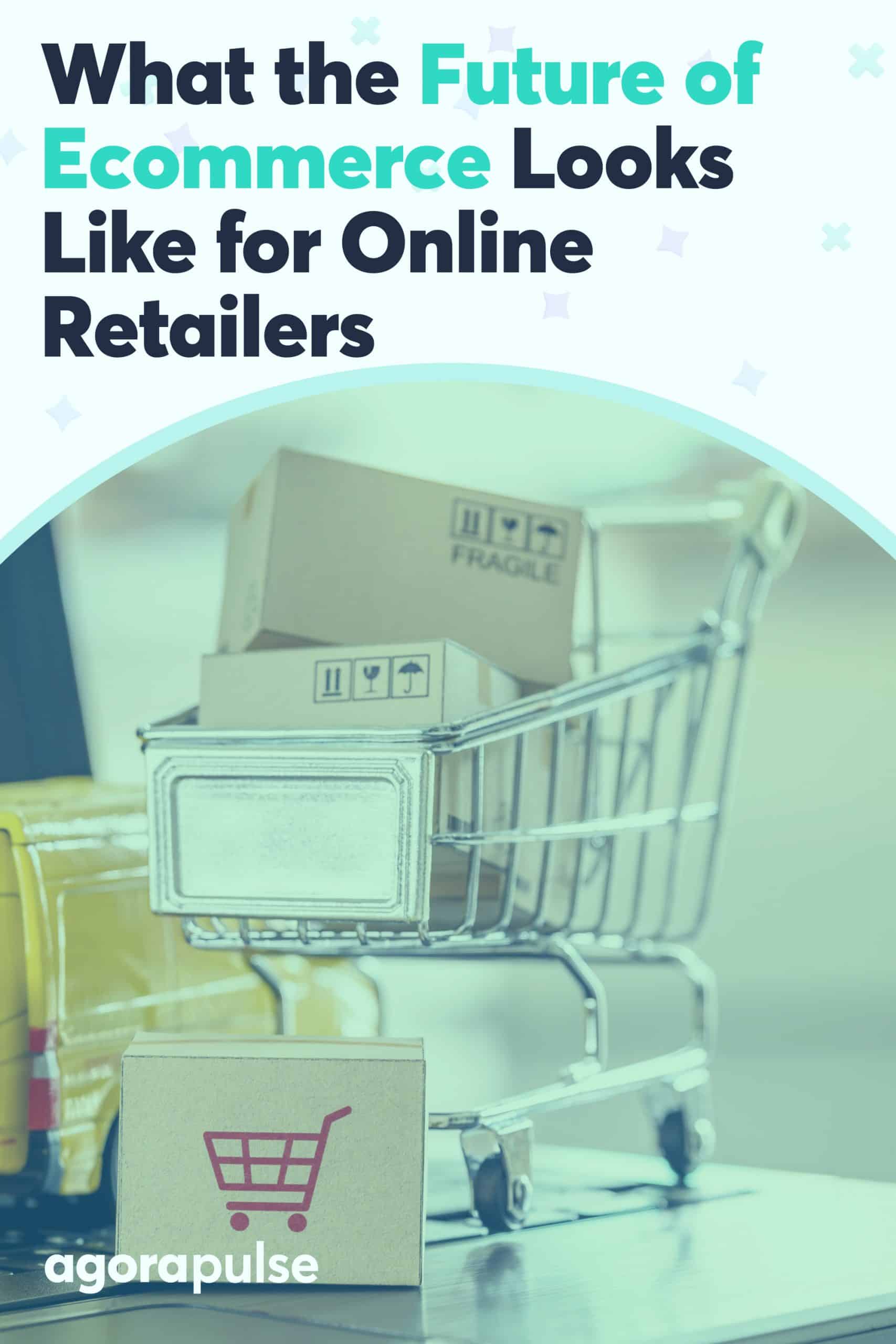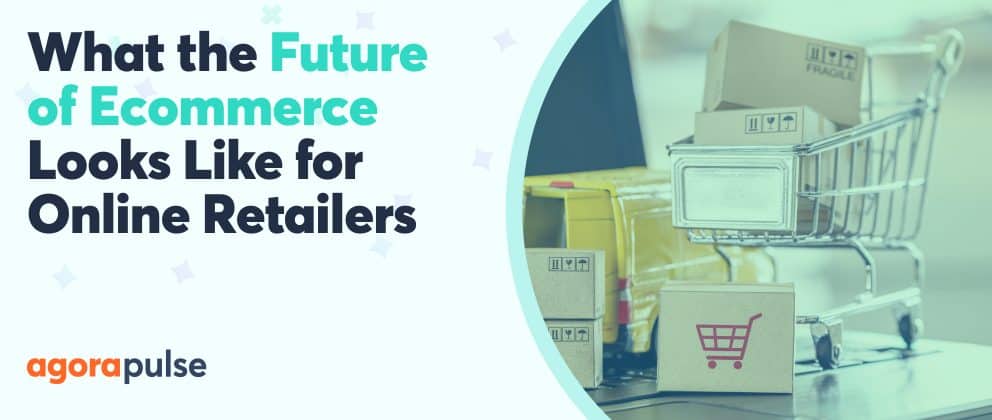As we slowly emerge from the global wreckage of COVID-19 and stagger our way back toward a normal life, we’re starting to see that the pandemic didn’t stop everything.
In just six months, during COVID, the ecommerce industry achieved more than five years of predicted growth.
Buying items from the comfort of your own home has become part of our “new normal.” So much so, that by the end of 2022, income from online sales is expected to reach over $6.5 billion.
“While shoppers are returning to brick and mortar, their ecommerce habits are set. Experts predict worldwide retail ecommerce sales will soar to just over 8 trillion dollars by 2026.” (The Future of Commerce, “Ecommerce Trends 2023: Top 15 Stats + Aspects Shaping Online Shopping”)
Although the ecommerce industry is booming, its rapid growth and development have given ecommerce retailers a new set of challenges.
Stick around as we go through what these challenges are, how to overcome them, and look at what’s next for the world of online shopping.
Biggest Challenges of Running an Ecommerce Business
In the United States, 9,302 physical stores closed in 2019. This was more than double the amount that opened.
The data proves that the rise of ecommerce was closing down retail areas and shopping malls—even before the pandemic hit.
But when COVID did land, what challenged retailers was the speed at which the ecommerce industry grew.
Almost overnight, there was a huge increase in online competitors. Customers began to expect more from their online shopping experiences. A massive demand for products and services to be delivered quicker than ever erupted.
These challenges—and many others—are still pushing online retailers to the max.
Let’s take a closer look.
Current ecommerce challenge #1: Keep data secure
We can’t talk about the challenges of ecommerce without mentioning data security.
Horror stories are constantly circling big brands like Target and Home Depot, who recently had millions of credit and debit card details stolen by hackers.
No wonder that ecommerce customers are concerned about how ecommerce retailers will keep their data secure.
The problem is, as technology gets more advanced, so do the fraudsters. On average, around 4,800 websites a month are compromised by hackers who can break into servers, infect websites with viruses, and steal confidential data.
Although difficult to quantify, a data and security breach can cost an average business around $4.35 million.
But data breaches don’t just cost money. They can cost a brand’s reputation, too. The damage to a brand’s reputation after a serious data scandal can often be irreversible, causing one in eight ecommerce businesses to fail.
Consumers expect ecommerce retailers to protect their identity and transaction details from sophisticated hackers.
Current ecommerce challenge #2: Manage the rise in customer expectations
In many ways, online shopping has changed our lives for the better.
No more rushing to reach the store before it closes.
No more trekking out in the rain to get groceries.
No more battling for parking spaces at busy malls.
No more fighting through heaving retail crowds on a busy Saturday afternoon.
But the convenience of being able to buy whatever we want, whenever we want, without leaving the couch, has turned people into demanding consumers.
We want what we want, and we want it now.
And if we can’t get it from you? We’ll leave, get it from someone else, and never return, claiming “a terrible customer experience” as the reason.
In fact, 65% of customers have used a different brand because of a “poor experience.” Some 78% have backed out of a purchase because of it.
But the convenience of online shopping isn’t the only factor that has created this expectation of immediacy.
Tech giants, such as Amazon, with their complex shopping algorithms, one-click checkouts, and next-day delivery guarantees have set the expectation bar sky-high for customers, leaving small-to-mid-tier ecommerce retailers struggling.
Current ecommerce challenge #3: Maintain a consistent omnichannel experience
Amazon might exceed customer expectations during the browsing, checkout, and shipping process, but it’s not just the ecommerce website that needs to offer consumers this type of seamless experience.
73% of ecommerce customers will browse multiple channels before they purchase a product or service. So, customers are becoming increasingly particular about their entire journey with an ecommerce retailer. They expect the same experience, across all your touchpoints—from your website and social media pages to the phone calls and emails that you send.
“Shopping journeys don’t end—or often start—on a company or brand website. Loyal customers will follow your social media pages, engage with your brand, act as brand advocates, and they’ll also compare prices across different brands and platforms.” (The Future of Ecommerce, “Ecommerce Trends 2023: Top 15 Stats + Aspects Shaping Online Shopping”)
From the beginning search and research phases right through to the consideration and final purchase stages, brands are under constant pressure to offer a coherent, consistent, and smooth experience across all their channels.
Current ecommerce challenge #4: Secure high-quality leads
Capturing red-hot leads has been an age-old problem for thousands of marketing and sales teams, long before digital was even a thing.
But the rapid rise of ecommerce retailers has pulled this challenge right into the spotlight.
Social media platforms, email campaigns, and SEO strategies have made steering traffic to a website easy. But capturing website traffic that is likely to convert? Not so easy. Only 2.57% of website visits will convert into sales.
The problem lies in communicating the right message on the right platforms to the right audience.
After all, only interested people will convert. It’s about quality, not quantity.
Current ecommerce challenge #5: Fight big competitors with big marketing budgets
Social media platforms have leveled out the marketing playing field, meaning you no longer need a big budget to run an effective marketing campaign.
But big brands are still managing to monopolize the social media marketing space with their big budgets.
For instance, Walmart spends around $9.3 million a year on celebrity influencers, including chef Jamie Oliver, actor Neil Patrick Harris, and NBA star LeBron James.
Related Read: What the Future of Ecommerce Looks Like for Online Retailers
How to Overcome the 5 Biggest Ecommerce Challenges
As I write this, an estimated 12–24 million businesses are selling their wares online to a global marketplace.
That makes it clear: Five of the biggest challenges that ecommerce retailers are currently facing can be overcome.
Here’s how.
How to keep data secure, as an ecommerce retailer
Hackers can sniff out a gap in data security and exploit it within seconds. So, you must make sure no holes in your data security measures exist.
For starters:
- Make sure that your ecommerce website is running on the latest, most up-to-date version. Outdated software will put your website at risk of a Denial-of-Service (DoS) attack. During a DoS attack, the hacker will bombard your server with a huge number of targeted requests with the intention of overloading it.
- Become Payment Card Industry Data Security Standard (PCI DSS) accredited. This will give you and your customers the peace of mind that your data security protocols will protect their data.
- Install firewall software and plugins onto your website that will protect against suspicious networks but allow normal traffic through.
- Create strict cyber security policies and enforce them throughout your company.
- Limit the number of customer login attempts that your site allows. If hackers are trying to illegally log into your site, they’ll probably try multiple different passwords. If they exceed the number of login attempts your site allows, their IP address will be blocked. They’ll be unable to log into your site again.
- Make sure that the ecommerce website platform you’re using offers security features and compliance options such as multi-factor authentication, customer data encryption, and real-time threat alerts.
How to manage the rise in customer expectations as an ecommerce retailer
“Throughout 2020 and 2021, many consumer federations from different parts of the world noted an increase in the number of complaints from users about online shopping experiences. This does not mean that online experiences were worse: the problems and shortcomings were already there. As the number of buyers increases, the need to improve is becoming more evident.” (Sales Layer, “11 Challenges for ecommerce in 2022”)
To meet rising customer expectations, you need to listen to what people are saying about the experiences they’ve had with you. Then analyze the experiences that your competitors are offering their customers.
Only then can you offer your customers the experiences they seek.
However, you should follow these standards to keep your customer’s experiences happy.
Create personalized customer experiences
Customers want to feel acknowledged and valued right from the start of their journey with you. So, analyze their behavior patterns, evaluate their preferences, and pay attention to the choices they make.
Use that knowledge to create personal experiences for them.
Doing so could be as simple as using their name when they log in, sending them specific notifications, alerts, or product updates, and recommending products or services similar to what they’ve bought or looked at previously.
A little goes a long way when making an online experience personal.
Get your logistics sorted
Consider partnering with a reliable and experienced supply chain company. It might cost you extra, but if a customer can get their new watch 24 hours after ordering it, why would they wait five days?
You also may want to give them a bonus, provide the option to pick it up from a local store. (More on that later.)
Make your returns policy quick and easy
Making the process of returning goods as effortless as possible for customers may seem counterintuitive. (After all, returns are a cost to the business.)
But think of it this way: If you make it difficult for customers to return items, they’ll probably still return that item—but they’ll probably never return to you.
Give customers multiple payment options
Offer customers different ways to pay online. Commonly used payment methods to consider include PayPal, Google Pay, and WeChat.
It’s also a good idea to give customers the option to pay in monthly installments. This gesture not only helps people on a tight budget, but it also creates loyalty later down the line.
Offer impeccable customer service 24/7
96% of customers will leave you for a competitor if they experience poor customer service from you. They expect their questions to be answered or their complaints to be resolved within hours, not days.
Hire a team of dedicated and fully trained customer support reps willing to go above and beyond for your customers.
How to maintain a consistent omnichannel experience as an ecommerce retailer
To create and maintain a fluid omnichannel shopping experience, you need to be consistent in the way you communicate with your customers on your website, and across all of the other channels you utilize, such as social media.
Work out which channels your customers use, and integrate software that links all these channels together. That way, you can maintain a consistent dialogue when you talk to the same customers on different platforms.
Keep branding the same across all of your channels, too. Customers should instantly know that it’s you as soon as they lay eyes on your website, see an email that you’ve sent, or stumble across one of your ads on social media.
For example,when you enter a Hilton hotel, for example. You know it’s the Hilton as soon as you step through the door, don’t you? The colors, the logo, and the lobby layout just screams “The Hilton.”
Messaging and tone of voice are equally as important. Make sure that the same, clear messages are carried out, across all of your channels, especially when you run campaigns.
How to secure high-quality leads, as an ecommerce retailer
As we established earlier, securing red-hot leads comes down to attracting the right type of interested people.
First, you need to know who the “right type of interested” people are:
- Who are they?
- How old are they?
- Where do they live?
- Where do they hang out?
- What do they do for fun?
- What are they interested in?
- What are their pain points? (And can you resolve them?)
Find answers to these questions by analyzing your existing customers. Send surveys, observe their behavior on your website, and track their journeys from research to conversion to establish which channels they use the most.
Get to know your audience, inside out.
Take that information then build out a set of detailed personas. Use these personas to create targeted marketing messages you can publish in places where you know they’ll get seen.
If you understand your audience, your messages will hit home. You’ll filter out truly interested and intentional people from those who are just semi-curious and uninterested.
Paid ads and SEO strategies are good for reaching potential customers who are searching for a specific product or service. Just remember to keep your key terms specific and niche.
How to fight big competitors with big marketing budgets, as an ecommerce retailer
You might think it’s impossible to compete with brands that spend thousands of dollars on the hottest celebrity influencers, all-singing, all-dancing campaigns, and fancy, flashy ads.
But wait. Did you not hear?
Authentic is in, and fake is out.
Regardless of how beautiful something might look, anything too-perfect feels unattainable, empty, and dishonest to today’s savvy customers.
They prefer raw, behind-the-scenes footage, home-shot videos, and a no-holds-barred honest approach to marketing.
With the rise of visual platforms like TikTok, brands can reach more people, show their authentic selves, and hook their audience in with real-life videos that inspire engagement.
If influencer marketing works well for your brand, rather than shell out thousands for a macro-influencer or celebrity to endorse your product or service, partner up with a micro-influencer.
Micro-influencers are “normal” people who have carved out a niche for themselves on social media. They have a smaller following than the average celeb or macro-influencer, which makes them more affordable but no less effective. That is because most micro-influencers genuinely like and use the products and services they endorse. They refuse to work with brands they don’t like, and this shows up as authenticity. They earn respect and trust from their followers because they have a real passion for the products and services they choose to endorse.
(We’ve also written an e-book on influencer marketing, which goes into detail about working with micro-influencers.)
What Does the Future Hold for Ecommerce Brands?
Here’s a sneak peek into what the future looks like for ecommerce retailers.
Future ecommerce trend #1: Social commerce
The rise of social commerce won’t come as a surprise to you. Customers love to scroll, so they can keep up with the latest trends, soak up suggestions, and shop ‘til they drop.
“Global sales via social media platforms were estimated at 992 billion U.S. dollars in 2022,” according to The Future of Commerce.
Social media has become one of the best ways to meet, engage, and sell to target audiences. So, it’s expected to generate $30.73 billion and account for 20% of global retail sales by the end of 2023.
Key takeaway
To capitalize on the social commerce trend, build a close-knit community by:
- Working with relevant and authentic influencers
- Creating targeted paid ads
- Publishing a steady stream of engaging, organic content across the social networks that your audience uses
To make sure that your social media activity is cost-effective, invest in a social media management platform. Social media management platform, Agorapulse will make the process of planning and publishing social media content, managing comments, and interactions, reporting on performance, and proving Social Media ROI quick, simple, and easy.
Future ecommerce trend #2: Mobile commerce
Online doesn’t just mean ‘on a computer’’ anymore. Not when mobile phones can do as much as a laptop or a computer can.
Currently, 71% of retail traffic comes from mobiles, and 61% of sales are made from mobile devices.
Mobile commerce (also known as m-commerce) will be a key platform for ecommerce sales in 2023 and beyond. The ease and convenience of purchasing items through a phone means that by 2024, m-commerce sales will reach $4.5 trillion, and make up 69.9% of total retail ecommerce sales.
Key takeaway
- Adopt a mobile-first approach to everything that you do. All the channels you utilize, from your website pages to your social media posts, need to be designed for mobile devices as a priority.
- Build a mobile commerce app, offer multiple mobile-friendly payment options, like Google Pay or Apple Pay.
- Focus on mobile marketing tactics, such as SMS notifications or in-app messaging, to reach your audience.
Future ecommerce trend #3: Recommerce
The future generations are motivated by making sure that there’s a world left for them to live in, in 50 years’ time. This is why recommerce, where brands sell previously owned, new or used products to stop consumerism and protect the environment, is rapidly rising—especially among the planet-conscious Gen Zers and millennials.
Over a third of global consumers would pay more for a sustainable product. Moreover, four out of five would purposefully choose a brand that practiced sustainability and did its bit to protect the environment over a brand that didn’t.
Ecommerce brands that don’t take sustainability seriously will suffer.
Key takeaway
Look at brands like Patagonia to see how they’re practicing sustainability and offering recommerce options to their customers.
Future ecommerce trend #4: Inflation and tight budgets
With the economy feeling about as stable as jelly at the moment, times are tough, budgets are tight, and shoppers are more mindful about what they buy.
Inflation is likely to impact consumer spending well into 2023. When financial worries are high, consumers need reassurance.
Key takeaway
Ecommerce retailers can give customers the reassurance they’re craving by offering them high-quality guarantees, budget-friendly options like tiered subscription packages, and quick and easy return policies. Not only will this alleviate shoppers’ anxiety, but it’ll also build up loyalty and goodwill.
Future ecommerce trend #5: Flexible fulfillment
Buy-Online-Pickup-In-Store (BOPIS) isn’t a new concept. But it became popular during COVID when people didn’t want to risk catching the virus by accepting a home delivery from a driver. It gave them the option to purchase an item online then pick it up from a nearby store when they were ready.
Even though we’ve returned to “normal,” shoppers aren’t ready to let go of the convenience that BOPIS offers them. It’s going to take off in 2023.
BOPIS is expected to be a $703 billion market by 2027.
Key takeaway
If you’re planning to give your consumers a BOPIS option, make it effective by highlighting it throughout the entire customer journey. Advertise BOPIS on landing or home pages, display it on product detail pages, and remind them about it on the checkout pages. These constant but subtle reminders will hook them into the sale and keep them moving forwards with the purchase.
What the Future of Ecommerce Looks Like for Online Retailers
The pandemic accelerated the growth of ecommerce. But the rapid rise of ecommerce has given ecommerce retailers some challenges to overcome.
- To keep customers’ data secure in a world full of hackers and fraudsters, they must make sure that their data security processes and protocols are watertight and taken seriously by all employees.
- To manage the rise in customer expectations, they must pay attention to what their customers are saying and what their competitors are doing. Online retailers must be able to adapt their ecommerce strategy to changing market conditions.
- To maintain a consistent omnichannel experience, they must communicate consistently across all the channels they utilize.
- To compete against big brands with big marketing budgets, they must capitalize on the customer demand for raw, authentic content.
As we move away from the pandemic, into a new normal, a new set of challenges (or opportunities) lie ahead for ecommerce retailers:
- Social media will become the best way to meet, engage, and sell to target audiences.
- A mobile-first approach will be key for conversions.
- Sustainability will be a differentiating factor in consumer decisions.
- Inflation will require brands to offer reassurance to customers.
Want to see how Agorapulse can help you build a better business by tackling social media management? Sign up for a free demo right now!






